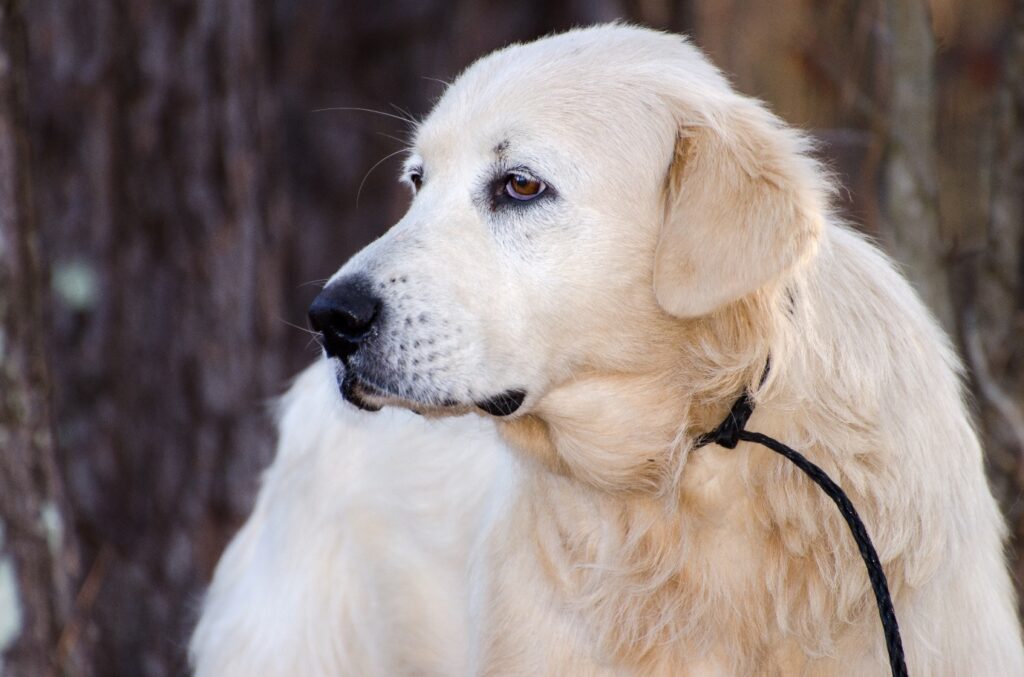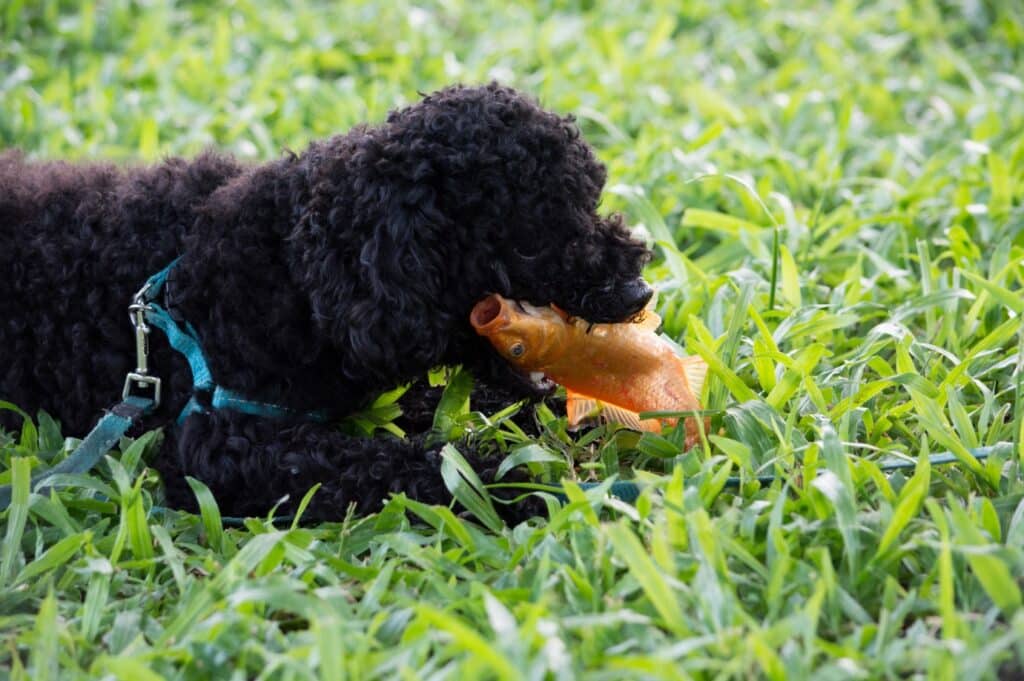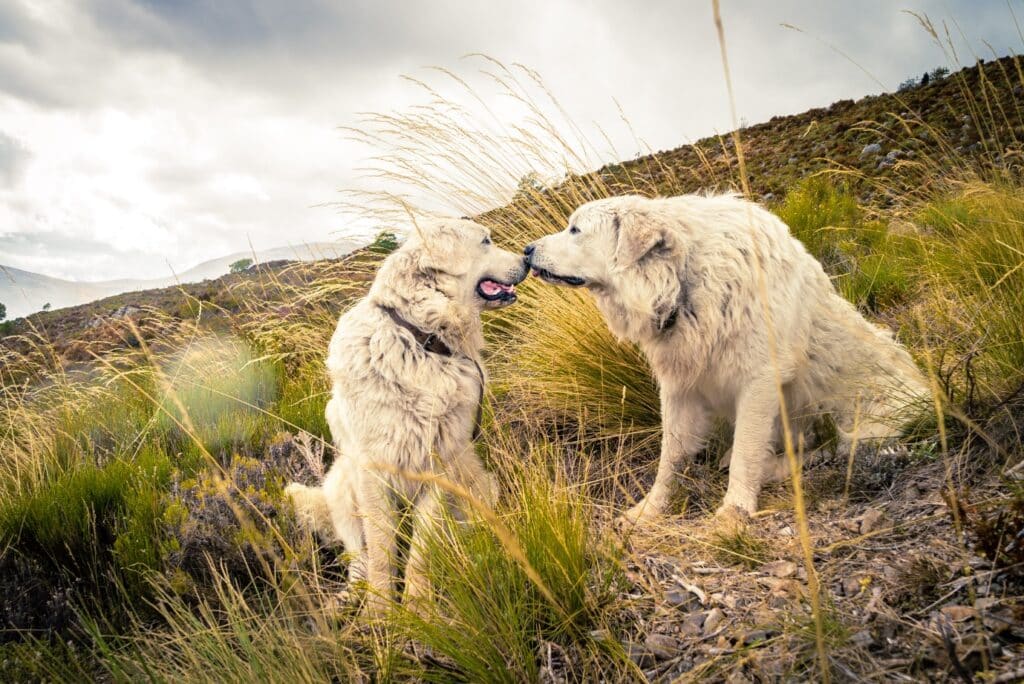The Pyredoodle is a mix of two popular dog breeds, the Great Pyrenees and the Poodle. This crossbreed is gaining in popularity because of its adorable looks and great temperament.
So what do you really know about the Great Pyrenees Poodle Mix (Pyredoodle)? In this blog post, we outline 19 surprising facts about this amazing mixed breed!
Pyredoodle – Breeding History
The Great Pyrenees Poodle Mix is a cross-breed between the Great Pyrenees and the Standard Poodle. This combination first came about in the early 2000s in Australia, though it is now becoming popular in the United States as well.
The reason for this popularity is likely due to the fact that the Pyredoodle combines the best of both breeds: the loyalty and protective instincts of the Great Pyrenees with the intelligence and trainability of the Standard Poodle.
In addition, Pyredoodles are low-shedding and hypoallergenic, making them a good choice for people with allergies. While the exact proportions of each breed can vary, most Pyredoodles are about 60% Poodle and 40% Great Pyrenees.
This mix results in a dog that is large (usually between 60 and 100 pounds), gentle, and loving. If you are looking for a new best friend, the Pyredoodle may be the perfect dog for you.
You may also like – Great Pyrenees Husky Mix (Pyrenees Husky) – 19 Key Facts!
Pyredoodle – Appearance
The Great Pyrenees Poodle mix is a large and fluffy dog that is sure to turn heads when out on walks. As with any mixed breed, the appearance of the Pyredoodle can vary depending on which parent breed they take after.
However, most Pyredoodles are large dogs with thick, fluffy coats. The coat can be either curly or wavy and is usually white or cream in color. Some Pyredoodles may have patches of color on their faces or bodies, but this is not common.
Pyredoodles have long, droopy ears and large, dark eyes. They also have a thick mane of fur around their necks, which gives them a regal appearance.
Pyredoodle – Coat & Colors
The coat of the Pyredoodle is one of its most distinguishing features. Most Pyredoodles have a thick, fluffy coat that is either curly or wavy.
The coat can come in a variety of colors, including white, cream, apricot, red, brown, black, and silver. The most common pattern is a mix of white and another color.
Regardless of their coat color or pattern, all Pyredoodles have one thing in common: a thick, luxurious coat.
Pyredoodle – Temperament

These dogs are known for being gentle, loving, and intelligent. They can be a bit independent, but they are also very loyal and will bond closely with their families.
With proper socialization, they will get along well with other dogs and animals.
Pyredoodle – Training Needs
Pyredoodles are intelligent and loyal dogs that make great family pets. However, they can also be stubborn and require consistent training. Like all dogs, the Pyredoodle needs basic obedience training.
This includes commands such as sit, stay, come, and down. It is important to start training early, as Pyredoodles can be difficult to train if allowed to develop bad habits. In addition to obedience training, Pyredoodles also need to be socialized from an early age.
This means exposing them to different people, places, and situations so that they learn to cope with new experiences. Without proper socialization, Pyredoodles can become fearful or aggressive.
However, with consistent training and socialization, the Pyredoodle can be a loving and loyal companion for years to come.
Pyredoodle – Are they Aggressive?
Pyredoodles are a popular new designer breed, and for good reason. They’re gentle, loving dogs that make great family pets. However, one potential downside to owning a Pyredoodle is that it can be quite aggressive.
This is especially true if the dog is not properly trained and socialized from a young age. Pyredoodles need firm, consistent guidance in order to learn how to interact appropriately with other animals and people.
Without this training, they may become frustrated or even aggressive. If you’re considering adding a Pyredoodle to your family, be sure that you’re prepared to provide the necessary training and socialization.
With a little effort, you can help your Pyredoodle learn to channel its aggression into positive energy and become a well-rounded, happy dog.
Pyredoodle – Exercise Needs

The Great Pyrenees Poodle mix, or Pyredoodle, needs plenty of exercise due to its high energy levels.
While each individual dog will have different exercise needs based on their energy level and health, in general, the Pyredoodle should get at least 60 minutes of exercise per day. This can include a daily walk or run, playing fetch in the yard, or going for a swim.
With regular exercise, the Pyredoodle should remain satisfied and will make an excellent companion for active families.
Pyredoodle – Mental Stimulation
They need mental stimulation to stay happy and healthy. A simple walk around the block will not be enough to keep them mentally and physically stimulated.
Instead, they need an activity that will challenge them both mentally and physically. One option is to enroll them in a dog agility class. This type of class provides both mental and physical stimulation, as well as socialization opportunities.
Other options include playing fetch or Frisbee in the park, going for hikes, or even taking swimming lessons. By providing your Pyredoodle with plenty of mental stimulation, you will help them to lead a happy and healthy life.
Pyredoodle – How to Groom them?
The Pyredoodle is a high-maintenance dog when it comes to grooming. They require regular brushing and professional grooming every six to eight weeks to prevent mats and tangles from forming in their long coat.
Pyredoodles also need to have their nails trimmed on a regular basis. In addition, they are susceptible to ear infections, so it is important to check their ears regularly and clean them as needed.
By taking care of your Pyredoodle’s grooming needs, you will help them to stay healthy and happy.
Pyredoodle – Are they Healthy?
The Pyredoodle is generally a healthy breed. However, like all dogs, they are susceptible to certain health conditions.
Some of the most common health problems seen in Pyredoodles include cancer, Cushing’s disease, bloat, and hypothyroidism.
To help ensure that your dog stays healthy, be sure to take them to the vet for regular check-ups and vaccinations. By staying up to date on their health, you can help your Pyredoodle enjoy a long and happy life.
Pyredoodle – Nutrition

As any dog owner knows, nutrition is important for maintaining a healthy pet. Dogs need a balanced diet of proteins, fats, carbohydrates, and vitamins in order to stay active and strong.
While each breed has its own specific nutritional needs, the Great Pyrenees Poodle mix is a large and active breed that requires a little bit more than average. In general, Pyredoodles should be fed twice a day, with meals consisting of high-quality dry food or pasture-raised meats.
To ensure that your dog is getting all the nutrients they need, it’s important to consult with a veterinarian or animal nutritionist.
Pyredoodle – Dog Friendly?

The Pyredoodle is a friendly and social breed. They love to be around people and other dogs, and they make great companions. However, they can also be protective of their family and home, so it’s important to socialize them from an early age.
To help your Pyredoodle become a well-rounded dog, expose them to different people, places, and situations on a regular basis. With proper socialization, the Pyredoodle will make an excellent family dog.
Pyredoodle – Child Friendly?
The Pyredoodle is a great breed for families with children. They are gentle and loving dogs that enjoy being around people. However, because they are also large and active dogs, they need to be properly supervised when around small children.
To help ensure that your Pyredoodle is safe around your kids, teach them basic obedience commands and never leave them unsupervised with children.
Pyredoodle – Do they Drool?
The Pyredoodle is not a particularly drooly breed. However, like all dogs, they do produce some saliva. If you are concerned about your dog’s drooling habits, there are a few things you can do to help reduce the amount of saliva they produce.
For example, you can wipe their face after meals and snacks, brush their teeth regularly, and give them chews and toys to help keep their mouth busy. By taking a few simple steps, you can help to keep the drooling of your Poodle Great Pyrenees mix under control.
Pyredoodle – Barking Levels
These dogs are known for being loyal, intelligent, and affectionate. They are also relatively easy to train and make great family pets. However, one potential downside of owning a Pyredoodle is their barking level.
Because they are bred from two vocal dog breeds, Pyredoodles tend to be quite vocal themselves. This means that they may bark more often than other breeds, which can be frustrating for owners who live in close quarters with their neighbors.
If you’re considering adding a Pyredoodle to your family, it’s important to be prepared for their potential barking habits. With proper training and consistent management, however, most Pyredoodles can learn to control their barking and only vocalize when necessary.
Pyredoodle – Adaptability to Weather
The Pyredoodle inherits the thick, double coat of the Great Pyrenees, making it well-suited for cold weather. The coat is dense and water-resistant, providing protection from both the elements and potential predators.
The Poodle parent breed contributes intelligence and trainability to the mix, while also lending its own hypoallergenic coat. This makes the Pyredoodle an ideal choice for people with allergies. However, the Pyredoodle’s coat also means that it does not do well in hot or humid weather.
If you live in an area with extreme temperatures, it is important to consider this before bringing home a Pyredoodle. With proper care and attention, the Pyredoodle can be a loyal and loving companion for years to come.
Pyredoodle – Life Expectancy
One of the most appealing things about the Poodle Great Pyrenees mix is their life expectancy. Thanks to their mixed heritage, these dogs can live up to 10 to 12 years, making them a great choice for families looking for a long-term companion.
The Great Pyrenees, one of the parent breeds, typically has a lifespan of 10-12 years, while the Poodle typically lives 12-18 years. As a result, it is not uncommon for Pyredoodles to reach the age of 10 years or more.
Pyredoodles are also relatively healthy dogs, and they tend to be less prone to health problems than purebreds. With proper care and nutrition, your Pyredoodle can be a loyal and loving companion for many years to come.
Pyredoodle – AKC Recognition
The American Kennel Club (AKC) does not currently recognize the Pyredoodle as a separate breed. However, the Pyredoodle is eligible for registration with the AKC Foundation Stock Service (FSS).
The FSS is a program that records pedigrees and tracks the development of new and emerging breeds.
While the Pyredoodle is not currently recognized as a separate breed by the AKC, this may change in the future as the breed continues to develop and gain popularity.
For now, however, Pyredoodles are not eligible for AKC competitions or events.
Pyredoodle – Puppy Prices
Prices for the Poodle Great Pyrenees mix can vary depending on a number of factors, including the breeder’s location, reputation, and litter size.
However, you can expect to pay anywhere from $700-$2800 for a Pyredoodle puppy.
Final Thoughts
If you’re considering adding a pyredoodle to your family, congratulations! You’ll be getting an amazing dog that is both intelligent and loving.
But before you bring your new pup home, make sure you’re prepared for the challenges – and rewards – of owning this unique breed.
Thanks for reading our blog post on pyredoodles, and we hope you enjoy learning about these fascinating dogs as much as we enjoyed writing about them.
You may be interested in – The Ultimate Great Pyrenees Guide – All Questions Answered!

